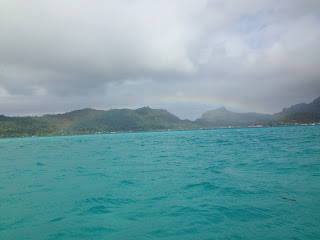"Ever
since happiness heard your name,
it has been running through the streets trying
to find you."
--Hafiz
Happiness and I definitely had a meaningful encounter in Bora Bora.
Like eating a good meal with a fine zinfandel, I wanted to savor fully this trip
before writing about it. I had many delightful first impressions of Bora Bora,
and it lived up to everything I had ever read about it. But of all the ports I
visited, the Bora Bora afterglow—the memories and the euphoric feelings they
evoke—has remained the longest.
Bora Bora, located about 160 miles northwest of Tahiti and
approximately 2,600 miles south of Hawaii has long been the muse
for artists, poets, authors, movies, and lovers. To say it is beautiful
understates the truth. And, its charm emanates from a more sensual place, like
a subtle perfume that conjures memories and hooks you into creating new ones.
 So much beauty forces you to pay attention to every
detail: the rich colors of the hibiscus; the turquoise blue waters of the
lagoon that surround the main island; the waves that crash against the reef so
intensely you can hear and feel them on the shore miles away; and the sun
rising behind the famous volcanic mountains.
So much beauty forces you to pay attention to every
detail: the rich colors of the hibiscus; the turquoise blue waters of the
lagoon that surround the main island; the waves that crash against the reef so
intensely you can hear and feel them on the shore miles away; and the sun
rising behind the famous volcanic mountains.
The main island and its smaller
siblings, completely surrounded by coral reefs, form a natural aquarium with some
of the most spectacular snorkeling and diving in the world.
 You can ride the 33 miles around the entire main island by bicycle. At
many points I had the view all to myself; on the windward side of the island I basked in the sun as the slow lap of the
waves seemed to whisper the wisdom of silence. In another spot a man burned
hibiscus trimmings [not a great smell], and at another a man fished.
Interestingly, the main island only has one sandy beach, so throughout the
island boats are kept on elevated rafters away from the shore [see photo above]. On some parts of
the main island, and also on the smaller ones, a few resorts have the famed
over-water bungalows that look like mushrooms from a distance.
You can ride the 33 miles around the entire main island by bicycle. At
many points I had the view all to myself; on the windward side of the island I basked in the sun as the slow lap of the
waves seemed to whisper the wisdom of silence. In another spot a man burned
hibiscus trimmings [not a great smell], and at another a man fished.
Interestingly, the main island only has one sandy beach, so throughout the
island boats are kept on elevated rafters away from the shore [see photo above]. On some parts of
the main island, and also on the smaller ones, a few resorts have the famed
over-water bungalows that look like mushrooms from a distance. 
 Music is as much
a part of the Tahitian lifestyle as the ocean. One afternoon I joined a small
boat tour given by a local named Mata and his son. As he drove us out to a
private island he played the Tahitian ukulele while his son played the
Music is as much
a part of the Tahitian lifestyle as the ocean. One afternoon I joined a small
boat tour given by a local named Mata and his son. As he drove us out to a
private island he played the Tahitian ukulele while his son played the
Despite the chill
the storm brought to the water and air temperatures, I decided to swim with the
lemon sharks in the lagoon. The visibility in the clear water allowed us to
watch the sharks as they appeared to glide through the water. Although I have
done shark dives in the past, this experience felt more relaxed and casual,
with each moment filled with gratitude more than fear. A little while
later our group swam with manta
rays, which seemed just as playful as our guide. The ride back into the lagoon,
singing songs and watching the sun set, felt like a dream. I have so many more
magical memories of Bora Bora, and I hope my pictures tell the story in a way
that words cannot. |
| Barbecue Bora Bora style |


































